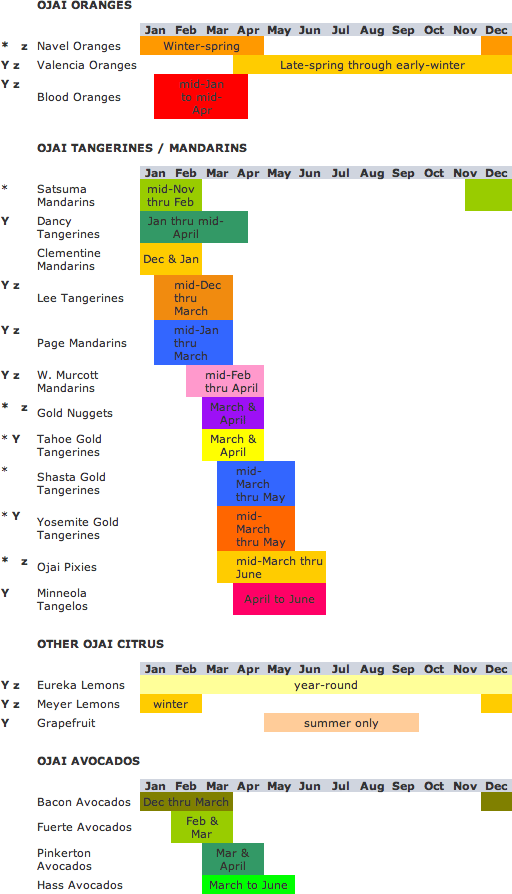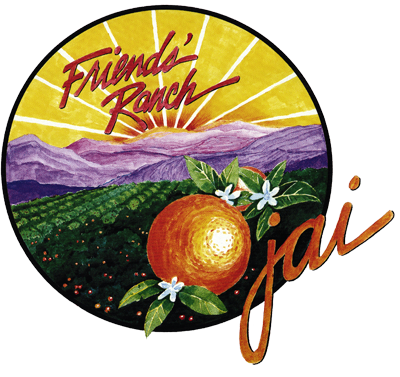Growing Seasons Chart
 We grow many varieties of citrus & have made this chart to help you understand their seasons. Mother Nature can cause seasonal variations from year to year.
We grow many varieties of citrus & have made this chart to help you understand their seasons. Mother Nature can cause seasonal variations from year to year.
* indicates seedless fruit
Y indicates a great juicer!
z indicates an excellent peel flavor, choice for zest

Ojai Sweet Oranges
* z Navel Oranges: ripe in winter months December-April
Varieties we grow include Washington, Cara Cara, and Late Navel.
Considered the “eating orange”, these oranges are seedless and easy to peel and are a favorite snack in the winter! They have a thicker peel and lower juice content than Valencias making them superb for eating and using in salads. The Cara Cara variety has a red hue.
Y z Valencia Oranges: ripe in the early spring to early winter (April-December)
Considered the “juice orange”, these oranges are packed with juice, making peeling them messy; best to cut up for eating. Valencias can regreen during the hot weather of summer, so don’t be fooled by bad looks. Late-summer Valencias are the best oranges we grow! Midknight Valencias are a seedless variety.
Y z Blood Oranges: ripe in winter (mid-January-April)
Varieties we grow include Moro, Tarocco and Sanguinelli.
All varieties have a red pigmented flesh due to more natural pigments with antioxidant qualities. They have a strong aroma and a spicy taste, fresh and pleasing in the winter months.
Of the varieties Friend’s grows the Moros have the reddest flesh and Taroccos the best flavor. Blood oranges make excellent and attractive juice especially when mixed with other citrus.
Ojai Tangerines/Mandarins
* Satsuma Mandarins: ripe in winter, usually starting around Thanksgiving
The first mandarins in season after summer, just in time for the winter holidays! These juicy treats are packed with their own distinctive almost-tropical flavor. They have a zipper
skin and are seedless, making them a perfect natural snack. Friend’s picks and sells them with a few leaves attached making a very attractive display for your fruit bowl or holiday table
arrangement.
Y Dancy Tangerines: ripe January through March
Dancys are one of the traditional favorites among tangerine lovers. Their amazing flavor has made them one of the most widely grown tangerines in the world. They are easy to peel. Don’t let their seeds deter you from snacking on these tasty treats! Also great for juicing! Friend’s picks and sells them with a few leaves attached making a very attractive display
for your winter fruit bowl or lunchroom.
Clementine Mandarins: ripe in December and January
Clementines were originally called Algerians. Folks from Europe and the east coast know Clementines well as they are grown throughout the Mediterranean and exported to the eastern US and throughout Europe. They are only seedless if grown in isolation from other citrus (if they cross pollinate with other citrus they will by seedy). Medium-sized fruit, easy
to peel with a smooth and glossy look. Fruit has a distinctive flavor with a slight essence of apricot. There are many varieties of clementines, our favorite is the Fina Sodea, a very flavorful and juicy variety.
Y z Lee Tangerines: ripe December through January
One of the best-flavored tangerines we grow! The season for Lees always comes and goes too quickly and one never seems to get their fill of this astounding fruit. Lees are quite
difficult to peel and do have seeds, but their flavor surpasses most other citrus. If you can’t get the knack of peeling them, try slicing them, or squeezing them for juice. Everyone loves
the flavor of a Lee Tangerine!
Y z Page Mandarins: ripe mid-January through March
Like Clementines, Pages will only be seedless if grown in isolation from other citrus varieties. The Page variety is a cross between a Clementine and Minneola. They have a very
attractive reddish peel, which is quite easy to remove, revealing a scrumptious fruit packed with juice. Friend’s only has a few trees of Pages, so they come and go quickly. They make
an excellent juice with a yummy sweetness!
Y z W.Murcott mandarins: ripe mid-February through April
W. Murcotts are a beautiful shiny, reddish mandarin with a distinct flavor. They are not truly seedless, and will only be absent of seeds if grown in isolation from other citrus.
Their easy peelabilty, beautiful color and juicy inside has made them into one of the most planted mandarins in California. (Much of the California W. Murcott crop is marketed under
the trade name Delite®).
* Y Tahoe Gold Tangerines: ripe in March and April
* Shasta Gold Tangerines: ripe mid-March thru May
The Shasta, Tahoe and Yosemite Gold mandarins are excellent new varieties, all derived from crossing Tangors, Dancy and Encore mandarin varieties; hence they were initially called
TDE’s. All three are beautiful, large, seedless and very juicy. They are generally easy to peel, although can be messy if full of juice and have a fruity, Minneola-like flavor. All
3 have distinctive qualities, the Yosemites tend to be very large, the Tahoes are juiciest, Shastas are rounder and easiest to peel. Try all 3 and see which you like best!
* z Gold Nuggets: ripe in March and April
Gold Nuggets were originally called “Pixie-Likes” due to their similarities with the Pixie. Gold Nuggets are truly seedless, easy to peel, juicy and very sweet. An excellent
piece of fruit! A real hit with children, great for lunchboxes.
* z Ojai Pixies: ripe mid-March until we sell them all, which is usually mid-June
Our favorite and the first choice of our customers at farmers’ markets! Seedless, easy to peel, and very sweet. These little lumpy-bumpy wonders are the perfect snack for any age. They
have a low acid content and 1-year olds and elderly are able to eat them up without a worry. Fruit size and appearance varies, they can be pale colored or lumpy-bumpy, but they
are all great on the inside! Try a few and you will be hooked! We like them so much that we helped make a bumpersticker about them….see www.ojaipixies.com
Y Minneola Tangelos: ripe April through June
The Minneola is a cross between a tangerine and a grapefruit, making a very juicy flavorful piece of fruit with a slight tang to it. This fruit has deep-orange flesh with few seeds
and minimal pith. Try making Minneola juice, it is excellent on its own, mixed with other fruit juices, or used in your favorite cocktail!
Other Ojai Citrus
Y z Eureka Lemons: ripe year-round
The traditional sour lemon. We pick ours when they are just turning yellow, which is when they have the highest vitamin content and best flavor. These lemons are great for cooking
with as their flavor is not lost with the heat of cooking.
Y z Meyer Lemons: ripe in the winter (December through February)
A sweet lemon! The Meyer lemon is the result of the hybridization of a lemon and tangerine. These lemons have a very distinct flavor and aroma, making an excellent juice or garnish for just about any dish. Their flavor is lost somewhat with cooking, so try and use Meyer lemons fresh. Try quartering these lemons in a pitcher of water to make a refreshing drink!
Y Grapefruit: ripe in the summer months (May through September)
Friend’s grows both white and pink varieties. White grapefruit tend to be more acidic, but with a more intense flavor. Our pink grapefruit tend to not color-up and sweeten until we’ve
had a few weeks of hot summer days. Both make excellent juice and are an excellent refreshing summer snack!
Ojai Avocados
A note: Avocados bruise easily even when hard (unripe)! Treat them gently whether they are ripe or not and you will have a much better piece of fruit. Many avocados in grocery
stores have been mishandled, resulting in those nasty brown spots and off-flavored fruit when they get ripe.
Bacon Avocados: ripe in the winter (December through March)
As the first variety to mature in the fall, many are picked and sold too early. A green skinned avocado, which does not turn color when ripe. Ready to eat when very soft to the touch
at both ends. Bacons have a thin skin and bruise easily. A very creamy, sweet avocado. Excellent for salads as they fall apart and make their own dressing. They can also be blended
fresh with oil and vinegar for a dressing. Also good for guacamole and sandwiches!
Fuerte Avocados: ripe in February and March
Fuertes were once the #1 avocado grown in California due to their excellent flavor and ability to withstand cooler temperatures. A green skinned avocado, which does not turn color when ripe. Fuertes are ready when soft to the touch at both ends. Fuertes are our favorite avocado for flavor with a subtle smoky flavor and balanced texture. Try them side-by-side with other varieties and see which you like!
Pinkerton Avocados: ripe in March and April
The Pinkerton variety originated from a seed of a Hass avocado that had been pollinated by another variety. Pinkertons are green skinned and do not turn color when ripe. They are ready when soft to the touch at both ends. Pinkertons are similar to Hass with a thicker skin, an excellent flavor and nice texture, but with a little less oil than a Hass.
Hass Avocados: ripe in the late spring (March through June)
The most widely grown avocado worldwide. The Hass is green skinned when immature and the skin blackens as it ripens. Ripe Hass will be evenly black and soft to the touch. Hass
have excellent flavor, nice texture and are easy to separate from the skin and pit.
